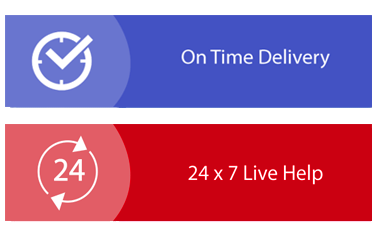PRJ5003 Project Constraint Management Report 2 Sample
Assignment Brief
This assessment is designed to assess students’ technical skills in planning and communicating a project plan effectively. Students are required to form a group (max. 4 students), select a project case (either from the provided links to the real-life projects or a project case of their group’s choice). The selected project (either ongoing or already completed) is to be assumed by your group to be in final stage of Initiation, with either a signed off Project charter or in the stage of getting the approval of the Project charter. Students’ are required to create the scope management plan, schedule management plan and cost management plan for their project. This report should include an introduction to the project case, a stakeholders’ register, and a brief project charter.
The Scope management needs to include project justification, in-scope and out-of-scope, constraints, Limits, assumptions, technical requirements and statement of work (SOW). WBS structure (minimum of three levels), WBS dictionary, work packages, scope verification and validation methods, scope change control, and designing the change control boards (CCB) and roles and responsibilities.
Working with their group, students will write a schedule management plan that includes processes, tools and techniques to be used and documents to be developed as per your client’s requirements, define activities (activity list, proper activity logic, activities identification), milestones list, activities sequence, relationships, project network and critical path(s) using MOST likely estimates of activity duration, roles and responsibilities in scheduling, and monitoring and controlling schedule (EVA relevant to project schedule). Provide a description of the methods and tools. The PERT section to be included and should demonstrate how the process from most likely, optimistic, and pessimistic duration to project probabilities have been implemented. You need to indicate most likely, optimistic, and pessimistic durations for each activity and calculate the activity expected times for all activities. Refer Marking rubric for detailed requirements including calculation of Project expected time (TE) using activity expected times and CPM along with calculation of activity standard deviations.
Using your project planning and scheduling skills and utilising the provided excel templates, you are required to develop a schedule plan and develop schedule baseline using the activity expected time (tE).
Students are also require to develop and write project cost management plan that includes: plan cost management (identify processes, tools and techniques to be used and project documents to be developed as per your client’s requirements), define cost elements (labour, material, variable cost), identify types of cost (direct, indirect, fixed, variable), determine the estimating method (s): (top- down,bottom-up), use estimating techniques (analogous, parametric, three-point method) to estimate budget (creation) and establish time-phased budget, provide a discussion on monitoring and controlling cost (EVA relevant to project cost including forecasting and variances), and establish a cost baseline.
For successful completion of this assessment, students will meet with their group regularly (at least once a week). Students will also be assigned to group Wiki page which will be their platform to collaborate with their group. The prescribed textbook and PMBOK are the main reference along with the recommended reading material. Groups expected to discuss their work with lecturer and to seek support.
Following resources may assist student in selecting a real-life project but the students could select any other real life case study project suiting their preference as a group:
.png)
Solution
Introduction
Background of the Project
The Perry Park Revitalisation Project is an initiative undertaken by the City of Sydney to meet the escalating demand for sports facilities in the southern regions of the city. The project, which commenced in July 2023, involves the construction of a new synthetic sports field at Perry Park, Alexandria. This is in conjunction with the strategy that seeks to increase the playing hours in local sports fields to 16000 by 2030. The decision to use synthetic material in place of the natural turf is based on two facts; the synthetic material can take more usage hence it provides more playing hours.
.png)
Figure 1: Perry Park Revitalisation Project map
(Source: Cityofsydney.nsw.gov.au, 2024)
This project is based on the background of an ever-increasing population density in the South Sydney region, which has led to an increased need for recreational areas. As stated by the City of Sydney (2024), the new field construction also caters for new amenities namely the amenities pavilion, lighting, seating, improve park entries and access pathways. This is not a simple sporting upgrade; it aims at addressing sporting needs as well as enhancing the functionality and looks of Perry Park for the assignment helpline.
Project Justification
The rationale for the project in Perry Park is diverse since it will yield numerous positive results for the inhabitants of the area. The main purpose is to fulfill the need for sport infrastructure in the region, which is lacking due to growing population. The conventional soccer fields have small capacity and high maintenance demands that reduce their availability for community uses. Synthetic fields, on the other hand, offer a durable and low-maintenance alternative, capable of withstanding heavy use and adverse weather conditions. Additionally, the project aligns with the City of Sydney's broader urban development goals, which emphasize the creation of sustainable and inclusive public spaces.
Constraints and Objectives
Several limitations have been noted in the implementation of the Perry Park project. These include environmental factors, constraint in financial resources and constraint in time. They plan to have 36 trees to be cut down in order to facilitate the construction of the project; authority must work hard to ensure that the ecological balance of the park is not affected. To counter this, 26 large local trees will be planted to provide shade and habit to local fauna respectively. Budget limitations are another significant issue; the overall cost of the project is expected to be $5 million. This funding plan must factor in the construction of the synthetic field, amenities pavilion, lighting, seating, and access enhancements. Another limitation is the time line where the project is expected to take 18 months at most depending on weather conditions. This means proper planning and organization in order to achieve optimum and timely results for the project.
The project has clear and measurable goals. The first objective is to enhance the sports’ fields’ capacity in south Sydney to allow for more hours of use and the expanding user base. Other goals are related to increasing the accessibility, recreational value, safety, and sustainability of the new facilities in the park. This shall also involve constant communication with the community and seeking for their feedback in order to ensure that the final result that is designed meets their needs.
Brief Project Charter
The Perry Park Revitalisation Project Charter defines the scope, goals and management plan of the project. As approved by the City of Sydney Council in the project proposal, the scope of work and the budget increase of the project have been approved (Meetings.cityofsydney.nsw.gov.au, 2024). The project team is involved in the procurement of the requisite approvals as well as documentation for construction works, tendering, and construction of the project. Other stakeholders include the local community, the sports organizations and environmental organizations which has been sought through consultations and feedback. Effective communication and stakeholder engagement are also highlighted in the project charter as part of the project management cycle. A project manager leads the governance structure, and a steering committee oversees the project and decision-making, while other committees are dedicated to specific aspects of the project.
Scope Management Plan
Identify Processes, Tools, and Techniques
The scope management plan developed for the Perry Park Revitalisation Project includes a set of well-defined procedures, tools, and methods that will help to achieve the project’s goals. The main ones are the scope planning process, scope definition process, and the scope validation process. Scope planning focuses on creating a comprehensive document known as the project scope statement that defines all the necessary tasks. Scope definition elaborates this statement into a clear and detailed WBS, which divides the project into work chunks. Scope validation also involves performing frequent reviews and inspections of the deliverables to ensure that they were developed in accordance with stakeholder specifications and expectations. Some of the tools and techniques employed are; WBS which is a hierarchical breakdown of the total work that needs to be accomplished. The WBS dictionary further elaborates every WBS element and thereby reduces the chances of backflipping. The needs of the stakeholders are identified through stakeholder analysis and proper identification of requirements through interviews, focus group discussions, and questionnaires. For controlling the scope changes, a change control process and formation of Change Control Board is also essential to control changes.
Roles and Responsibilities for Managing Scope
Thus, the management of the scope for the Perry Park involves knowing and defining roles and responsibilities. It is the responsibility of the project manager to manage the whole scope management process to ensure everything is done in line with the set scope. They interact with the project team, stakeholders, and the CCB to control scope and to ensure that deliverables meet required standards. The project team members are expected to perform their planned tasks based on the WBS and notify the project manager of any scope change or problem encountered. The local community, different types of sports organizations, and environmental groups contribute to the requirements gathering stage and the subsequent scope validation phase. The change control board is made up of key project stakeholders and consultants and their role entails approving or rejecting any proposed change of the scope in relation to the project objectives and constraints. Such cooperation also ensures that the project is scoped correctly to meet all the stakeholders’ needs and demands.
Detailed plan
Project Scope Statement
This is the rationale for the Perry Park Revitalisation Project that seeks to create a new synthetic sports field, upgrade park facilities and ensure ease of access due to increased demand of sports facilities in South Sydney. It entails construction of FIFA-sized synthetic playing field, new amenities pavilion, park lighting, seating, enhanced entries to the park and access ways. The project also includes felling and replanting trees for sundry reasons of managing ecological and safety risks. It is proposed that the project will commence on the 10th of July, 2023 and end by the 16th of July, 2025 with an estimated total cost of the project at $5 million AUD.
Limits and Assumptions
Some of the key limitations of the Perry Park Revitalisation Project are resource constraints, environmental constraints, and the project duration of 18 months. Some of the planning assumptions include availability of good weather, continued supply of material, and quick approval by the relevant authorities (Wideman, 2022). Here, it is assumed that stakeholder engagement is positive and supportive, so that there will be no disruptions to project progression. Also, the synthetic field is expected to have a longer life span and less maintenance cost than a natural field, thus increasing the park’s playing hours to meet the City of Sydney’s goal of improving community sports grounds.
WBS Structure
The Work Breakdown Structure (WBS) for the project is organized into five main phases: These are: Initiation, Planning, Execution, Monitor and Control, and Closing. Each phase is further broken down into specific tasks:Each phase is further broken down into specific tasks:
1. Initiation: Stakeholder Identification, Project Charter Development, Approval of Project Charter
2. Planning: Development of Project Management Plan, Resource Allocation, Risk Management Planning
3. Execution: Construction of Synthetic Field, Installation of Amenities and Infrastructure, Landscaping and Environmental Adjustments
4. Monitor and Control: Quality Assurance, Schedule Management, Cost Management
5. Closure: Project Review & Documentation, Stakeholder Approval & Sign-off, Project Handover & Closure
Work Packages
The listed work packages of each phase of the Perry Park Revitalisation Project are systematically broken down to achieve overall coverage of all the required activities. In the Initiation phase, the main activities include Identify Stakeholders, Develop the Project Charter, and Obtain Formal Acceptance of the Project Charter. These tasks are important to lay key project activities and to obtain authorisation to proceed with the project officially.
The subsequent phase of Planning also includes the Development of the Project Management Plan and Resource Planning as well as Risk Planning. Such activities are aimed at designing the project’s timeline, assign the required resources, and learn about possible threats and their management. The Construction phase can be described as the main construction activities that involve Construction of the Synthetic Field, Installation of Amenities and Infrastructure, and Landscaping and Environmental Adjustments. This phase includes the actual undertaking of the planned work and is important in providing project deliverables.
The fourth phase of project management is the Monitor and Control phase which comprises the Quality Assurance, Schedule Management, and Cost Management. These are important tasks to ensure that the project is on schedule and costs are on target while delivering the quality standard solutions (Ferede, Mashwama & Thwala, 2022). This phase entails constant review and subsequent modification based on the intended and specific objectives of the project. The Project Closure phase comprises
Project Review and Documentation, Stakeholder Approval and Sign-off, and Project Handover and Closure.
WBS Dictionary
1. 1.1 Stakeholder Identification
- Description: Identify and document all stakeholders involved in the project.
- Deliverables: Stakeholder register
- Duration: 5 days
- Resources: Administrative Assistant, Project Manager
- Cost: $2,600 AUD
2. 3.1 Construction of Synthetic Field
- Description: Construct a FIFA-sized synthetic sports field.
- Deliverables: Completed synthetic field
- Duration: 150 days
- Resources: Civil Engineer, Construction Workers, Safety Officer, synthetic turf
- Cost: $632,000.00AUD
3. 4.1 Quality Assurance
- Description: Ensure all project outputs meet quality standards.
- Deliverables: Quality assurance reports
- Duration: 286 days
- Resources: Quality Assurance Specialist, Safety Officer
- Cost: $107,536 AUD
Graphical and Outline Format of WBS
.png)
Figure 2: Work Breakdown Structure (WBS)
(Source: MS Project)
The following is the WBS that outlines the phases and sub-phases of the project:
Level 1: Perry Park Revitalisation Project
Level 2: Initiation, Planning, Execution, Monitor and Control, and Closing
Level 3: Individual activities within each phase (e. g. , identification of stakeholders, creation of the project charter, etc. )
Control (Cost) Accounts
The third level WBS involves the establishment of control accounts that help in monitoring of the budget. Every significant activity under the various phases of Initiation, Planning, Execution, Monitor and Control, and Closure has its control accounts through which costs and budgetary control are implemented (Trudeau, 2020).
Scope Validation and Control
Scope validation entails continual assessments and audits to check whether project outputs are in line with stakeholders’ expectations and are endorsed. Change control processes include controlling changes to the project scope and addressing them according to a planned change control process.
Scope Change Control
Change control of scope is done by a Change Control Board (CCB) that evaluates all changes proposed. It is responsible for assessing the implications made on the project time, cost, and scope before approving or declining them (Kelly et al., 2022). This ensures that any changes made are done in a controlled manner and the changes that are made are well recorded.
Change Control Boards (CCB) and Roles and Responsibilities
The CCB consists of high-ranking project members such as; the Project Manager, the Civil Engineer and a representative from the Sydney City Council. The CCB is accountable for change request approval and any changes made must be consistent with the set project goals and limitations.
Schedule Management Plan
The Schedule Management Plan for the Perry Park Revitalisation Project incorporates different processes, tools, and techniques to achieve timely project delivery. These include activity scoping, activity planning, activity duration estimating, and project scheduling (Thesing, Feldmann & Burchardt, 2021). To name a few, Gantt charts and project management tools like Microsoft Project are used for this purpose. Scheduling tools like Critical Path Method (CPM), Program Evaluation and Review Technique (PERT), and resource levelling are employed to control time and any possible slippages. The operational schedule must be periodically assessed and adjusted in compliance with the project goals and timeframe.
As observed in the Perry Park Revitalisation Project, the main role of the Project Manager is to manage the schedule of the project and ensure all the activities are done on the right time. The Project Manager has to liaise with the Civil Engineer and Construction Workers to time and size the activities correctly (Mac Donald Rezania, & Baker, 2020). The Cost Accountant supervises schedule effects on budget compliance, the Administrative Assistant helps keep track of changes and the project schedule.
Detailed plan
Activities
The Perry Park Revitalisation Project consists of a detailed activity list designed to ensure a structured and timely completion. The primary activities include:
- Stakeholder Identification (5 days): Identifying all stakeholders involved.
- Project Charter Development (10 days): Creating the project charter.
- Approval of Project Charter (5 days): Formal approval of the project charter.
- Development of Project Management Plan (15 days): Crafting the comprehensive project management plan.
- Resource Allocation (10 days): Allocating necessary resources for the project.
- Risk Management Planning (10 days): Identifying and planning for potential risks.
- Construction of Synthetic Field (150 days): Building the synthetic sports field.
- Installation of Amenities and Infrastructure (125 days): Setting up additional facilities and infrastructure.
- Landscaping and Environmental Adjustments (100 days): Enhancing the park’s environment.
- Quality Assurance (286 days): Ensuring the project meets quality standards.
- Schedule Management (286 days): Managing the project schedule.
- Cost Management (286 days): Overseeing project costs.
- Project Review and Documentation (30 days): Reviewing and documenting the project.
- Stakeholder Approval and Sign-off (15 days): Getting final approval from stakeholders.
- Project Handover and Closure (2 days): Final handover and closure of the project.
Activities Sequence Relationships
Activities in the Perry Park Revitalisation Project are arranged in order to facilitate a progressive flow. B comes after A, C comes after B, and D comes after C E and F come after D G comes after E and F H and I come after G J K and L also come after G M comes after L N comes after M H I J and come after N O comes after M.
Schedule Baseline Details
Perry Park Revitalisation Project schedule baseline includes the exact start and end of each activity that will be used as a reference tool in assessing the status of the project. By so doing, the project team would be in a position to notice the deviations and other actions that can be taken to ensure that the project is back on track as postulated by (Calderon Tellez et al., 2024).
.png)
Figure 3: Project Baseline
(Source: MS Project)
Project Network
The project network diagram also illustrates the sequence of the tasks and how they are linked. This diagram is crucial when it comes to the identification of the critical path and the timelines of the specific project.
.png)
Figure 4: Network Diagram
(Source: MS Project)
The scheduling displays the chronological order of the project to ensure that each activity relates to the overall program.
Gantt Chart
The use of a Gantt chart in the Perry Park Revitalisation Project indicates the time required to complete a particular task and the resources required. Major assignments consist of Civil Engineer (70%) and Construction Workers for synthetic turf construction, the Administrative Assistant (30%) and Project Manager (50%) for project review and Cost Accountant (50%) for scheduling.
Figure 4: Gantt Chart
(Source: MS Project)
Critical path
.png)
Figure 5: Critical Path
(Source: MS Project)
The activities on the critical path for Perry Park Revitalisation Project include Stakeholder Identification Activity, Project Charter Development Activity, Approval of Project Charter, and Development of the Project Management Plan. Other activities include Resource Allocation, Risk Management Planning, Construction of the Synthetic Field, Quality Assurance, Schedule and Cost Control, Project Review and Documentation, Stakeholder Approval, and Project Handover.
PERT
Optimistic and Pessimistic Durations
The times set for the Perry Park Revitalisation Project vary between being optimistic and pessimistic greatly. For instance, Activity A has an optimistic time of 5 days and a pessimistic time of 8 days. Likewise, Activity G has a wide variance with optimistic and pessimistic completing time of 150 and 35 days, respectively. These durations are useful in determining the optimistic and pessimistic times for each task (Rountree, Lopez and Thomas, 2022).
Calculation of Activity Expected Times
The expected time for each activity is calculated using the PERT formula: Expected Time (TE) = Optimistic + 4 × Most Likely + Pessimistic / 6
For instance, Activity A is expected to take 5 days while Activity B is expected to take 11 days.
Calculation of Project Expected Time (TE)
The Project Expected Time (TE) is the sum of the expected times of the activities which are on the critical path. The identified critical activities include A, B, C, D, E, F, G, J, K, L, M, N and O where overall expected time of the project is obtained by summing the expected time of these critical activities.
Calculation of Activity Standard Deviations
The standard deviation for each activity is calculated using: Standard Deviation = (Pessimistic − Optimistic) / 6 (Errida & Lotfi, 2021).
For example, Activity A boasts of a standard deviation of 0. 50 days, and Activity B has a standard deviation of 1 day.
Calculation of Activity Variances
The variance for each activity is the square of the standard deviation: Variance = (Standard Deviation)2
In the case of Activity A, the variance is 0. For Activity A, it is 25 days and for Activity B, it is 1 day.
Computation of Project Variance and Standard Deviation
The project variance is the sum total of the variances of all activities on the critical path. The standard deviation of the project is the square root of the project variance and can be used to calculate the general project risk (Stanitsas, Kirytopoulos & Leopoulos, 2021).
.png)
Figure 6: PERT calculation table
(Source: MS Excel)
Probability Questions
The standard deviation and expected time for the project will help determine the chances of a project’s completion at a given time frame. Assessing the PERT chart, it is possible to identify the chances of completing the project in 5% or 10% less than planned time.
.png)
Figure 7: PERT Chart
(Source: MS Excel)
This involves the comparison of the completion time with the project time and the distribution of the project completion time. Thus, using these values, it is possible to determine the likelihood of obtaining a faster schedule and make the necessary conclusions regarding possible changes to the schedule.
Cost Management Plan
Identify Processes, Tools, and Techniques
The cost management plan of the Perry Park Revitalisation Project entails a variety of processes, tools, and techniques. These are cost planning, cost estimating, cost determination, and cost controlling. These include cost estimating software, cost estimating spreadsheets, and project management tools such as Microsoft Project, among others (Ba’Its, Puspita & Bay, 2020). Such methods as analogous estimating, parametric estimating, and three-point estimating give reliable cost estimates.
Roles and Responsibilities in Cost Management
In the context of the Perry Park Revitalisation Project, the role of the Project Manager includes cost control and keeping the cost of the project work within set limits. It is the role of the Cost Accountant to facilitate on cost evaluation, cost control and cost reporting. The Civil Engineer and Construction Manager offer suggestions for labor and material costs, while the Quality Assurance Specialist oversees cost quality assurance.
Estimating Methods and Techniques
Top down Estimating: This approach focuses on making a rough calculation of the cost of a project by comparing the cost of previous similar projects. It is useful for giving a rough or first approximation (Bodunwa & Makinde, 2020).
Bottom up Estimating: This method entails approximating the cost of each activity or work package and totaling them to arrive at the project cost. It gives a clear and specific figure.
Analogous, Parametric, and Three-point Method
Analogous Estimating: This technique involves making cost estimates from data collected from other similar projects. This is less precise but more efficient and straightforward.
Parametric Estimating: This method involves the use of statistical correlation between past records and other factors to arrive at forecasts. It is more accurate than analogous estimating (Xing & Xin, 2022).
Three-point Estimating: This approach employs three estimates for each of the tasks, optimist, most likely, and pessimist. It gives a better indication since probability and risk are taken into account.
Cost Elements
The project involves several cost elements:The project involves several cost elements:
Labour Costs: This covers the cost of remunerating the human resource involved in the project including the Project Manager, Civil Engineer, Construction Workers, and the Quality Assurance Specialist.
Material Costs: Encompasses the cost of the synthetic turf as well as any other miscellaneous items.
Variable Costs: Expenses that depend on certain aspects of the particular project, for instance, extra hours worked and more materials purchased as a result of project hitches.
.png)
Figure 8: Resource Sheet
(Source: MS Excel)
Types of Cost
The project costs are categorized as:The project costs are categorized as:
Direct Costs: Expenses that are directly linked to the project like salaries of workers and the cost of the components used.
Indirect Costs: General expenses that do not relate to a particular job, for example, rent and water bill.
Fixed Costs: Expenses that do not change based on the progress of the project, for instance, the wages paid to permanent employees.
Variable Costs: Expenses that change as the project continues, for example wages paid to temporary employees per hour.
Activity and Work Package Wise Cost Estimates
Each activity and work package in the project plan has cost broken down to the detail level. For example:
Stakeholder Identification (5 days): $2,600 (Administrative Assistant, Project Manager)
Project Charter Development (10 days): $5,040 Cost Accountant and Project Manager
Construction of Synthetic Field (150 days): $632,000 (Civil Engineer, Construction Workers, Safety Officer, Synthetic Turf)
Contingency Reserves in the Estimates
Contingency allowances are factored into the cost plans to cater for circumstances that are unforeseen and or risky. These reserves make it possible for the project to cater for any eventuality that may happen without straining the set budget. For example, a contingency allowance of 10 percent of the total estimated project cost may be provided for in a project.
Time-phased Manner to Represent Cost Baseline
The cost baseline is presented in the time-phased manner, where costs are associated with the activities in the project schedule. This made easier the monitoring and control of costs throughout the duration of the project. Budgets are spread out over different phases to ensure that costs are incurred in proportion to the progress of the project.
Monitoring and Controlling Costs
Project costs are managed using Earned Value Analysis (EVA). Key metrics include:
Planned Value (PV): The anticipated worth of work expected to be accomplished.
Earned Value (EV): The original value of work performed.
Actual Cost (AC): Specific expenditure made in relation to the work that has been completed.
Cost Variance (CV): EV - AC, signifying if the project was over or underbudget.
Cost Performance Index (CPI): EV/AC ratio offering the cost-benefit analysis of the project, expressing it in Senses & Kumral (2024).
Recalculation of EVA on a more frequent basis means that cost fluctuations are quickly detected and addressed to ensure compliance with budget lines. This systematic approach to cost management makes sure that the Perry Park Revitalisation Project stays affordable and in accordance with fiscal goals.
Conclusion
The detailed management plan of the Perry Park Revitalisation Project guarantees its successful implementation within the set funds and time frame. Some of the areas include clear description of the scope, schedule, and cost plan, adequate resource plan, and risk management plan. The critical path and PERT analysis give a detailed plan and overview of the prospective risks that have to be monitored and addressed on time. Last words stress the need to constantly assess and regulate the process in order to correct any deviations. The project team should continue cost and schedule assessments with the help of Earned Value Analysis (EVA). Recommendations include keeping all project stakeholders informed, updating the project plan to reflect real progress, and properly addressing reserves for contingencies.
Reference List
.png)
.png)




.png)
~5.png)
.png)
~1.png)























































.png)






